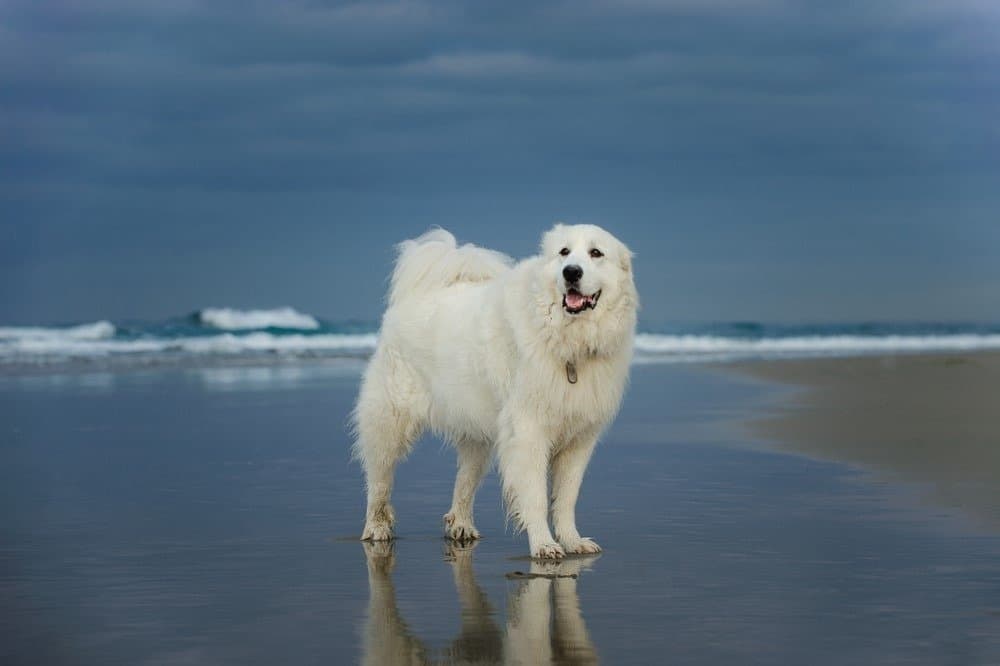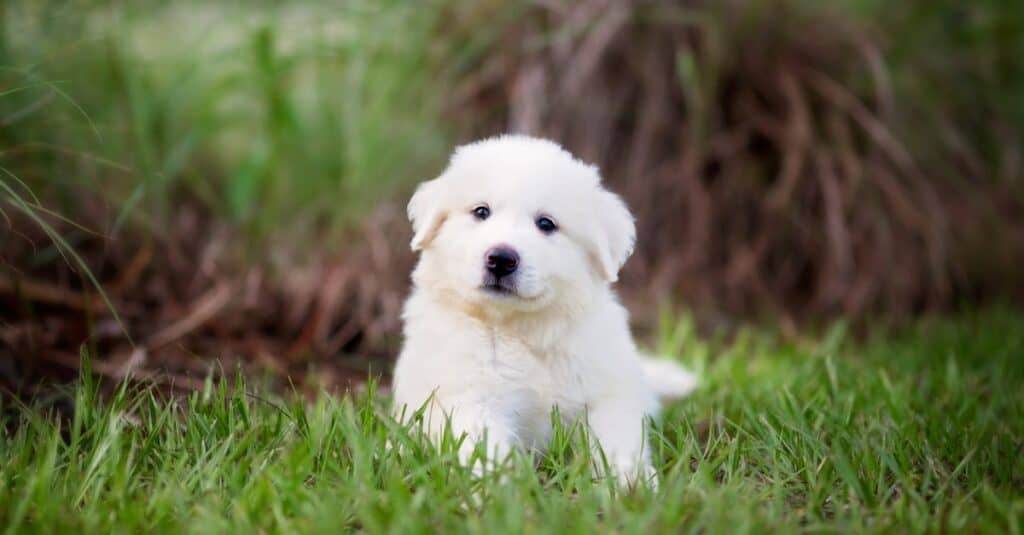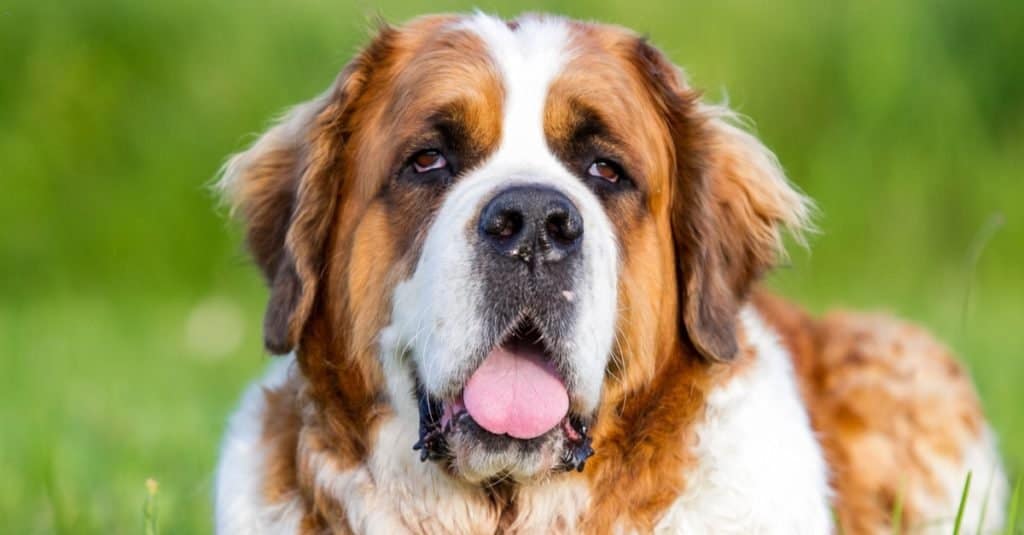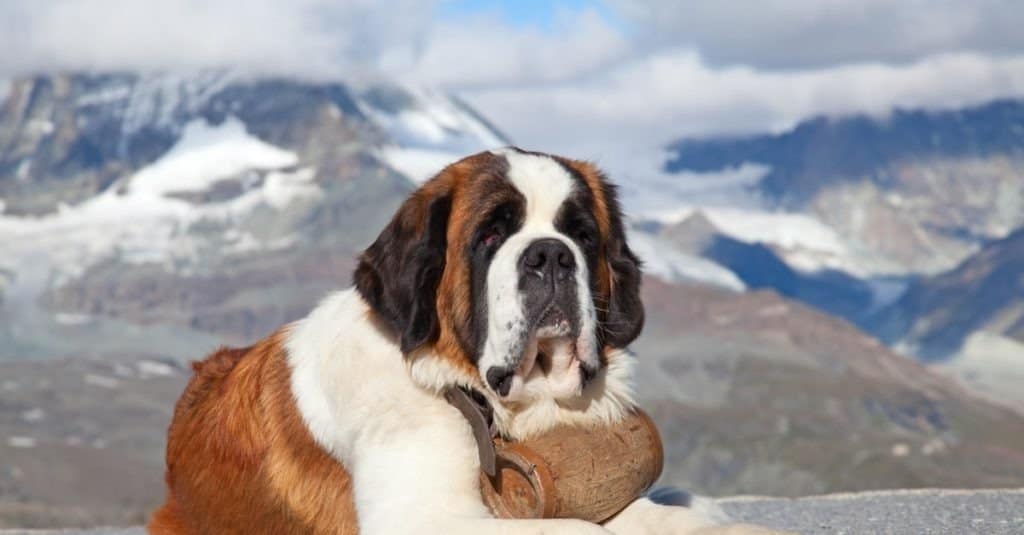The Great Pyrenees and St. Bernard are two giant guardian breeds with a lot of similarities! You may be wondering, how can you tell them apart?
Great Pyrenees dogs tend to be slightly larger, and their coat is white with markings, while St. Bernards have a larger variety of coat colors. St. Bernards tend to be more child-friendly and adaptive, while Great Pyrs are more vocal.
Great Pyrenees dogs live a couple of years longer on average and drool less than St. Bernards.
Let’s continue to explore these dogs in-depth below!
Comparing Great Pyrenees vs St Bernard

| Great Pyrenees | St Bernard | |
|---|---|---|
| Size | 25-32 inches, 85+ pounds | 26-30 inches, 120-180 pounds |
| Coat | White medium-length double coat with tan, gray, badger, or reddish-brown markings | Bicolor short to long double coat with possible black mask marking |
| Lifespan | 10-12 years | 8-10 years |
| Temperament | Protective, affectionate, vocal | Protective, affectionate, good with children, adaptable |
| Drooling Level | Moderate | High |
| Health | Prone to bloat | Prone to bloat, brachycephalic |
Key Differences Between Great Pyrenees and St Bernard
The key difference between a Great Pyrenees and St. Bernard is their health, and other differences include size, coat, lifespan, temperament, and drooling frequency.
Let’s dig into these differences below to learn more about these protective giant breeds.
Great Pyrenees vs St Bernard: Size

Great Pyrenees are the largest of the two, with males standing up to 32 inches tall and weighing over 100 pounds with no upper weight limit.
©everydoghasastory/Shutterstock.com
Both breeds are considered giant, but the Great Pyrenees is slightly larger. They max out at 32 inches in height and have no maximum weight, according to the American Kennel Club (AKC) breed standard.
Female Great Pyrenees dogs weigh 85+ pounds while males weigh over 100 pounds.
St. Bernard females are 26-28 inches tall and weigh 120-140 pounds. Males are 28-30 inches tall and weigh 140-180 pounds.
When considering a giant breed, it’s important to understand the pros and cons of these magnificent dogs. They make great guardians for your home, family, or livestock, and they’re typically big softies with their own families!
However, they’re also the most expensive dogs due to their size. They can be difficult for most people to handle on a leash or to lift if needed in a medical crisis.
Great Pyrenees vs St Bernard: Coat
Great Pyrenees dogs always have medium-length white coats. According to the breed standard, they can also have the following coat markings:
- Tan
- Grey
- Badger
- Reddish-brown
St. Bernards are typically bi-colored. Although most people know them as long-haired, there are also short-haired St. Bernards.
The AKC breed standard allows for the following coat colors:
- Brindle and white
- Brown and white
- Mahogany and white
- Orange and white
- Red and white
- Rust and white
- White and brown
- White and orange
- White and red
They may also have black mask markings.
Great Pyrenees vs St Bernard: Lifespan

Great Pyrenees dogs live 10-12 years, which is quite a long time for a giant breed!
©iStock.com/ktatarka
Giant dogs tend to live shorter lifespans than smaller canines. Interestingly, in this case, the larger of these breeds—Great Pyrs—live a few years longer at 10-12 years, and St. Bernards live an average of 8-10 years.
Some dogs will live shorter lives while others will live longer. Although our dogs’ lifespans aren’t entirely in our control, there are some things you can do to help your dog stay healthy and live longer.
This includes feeding them a well-balanced diet consisting of high-quality dog food, providing daily exercise, monitoring them for health problems, and visiting the veterinarian for regular check-ups.
One thing to look for in these deep-chested breeds is bloat, which we’ll discuss further below in the health section.
Great Pyrenees vs St Bernard: Temperament
These guardian breeds are protective and may be wary around strangers, especially if not well-socialized. However, they’re gentle giants with their families, and they might be clingy and will definitely want to be in on family activities.
As a rule, St. Bernards tend to be better with children, though every dog is different. Remember always to supervise children and dogs. Teaching each how to interact with one another is also important.
St. Bernards might also be more adaptable to change, though Pyrs shouldn’t handle it too badly! All dogs thrive on routine and will take time to adjust to new situations.
Lastly, Great Pyrenees dogs are more vocal. They bark moderately but may develop problem barking behaviors due to boredom or stress. St. Bernards seldom bark and are likely to do so only to alert.
Great Pyrenees vs St Bernard: Drooling Level

St. Bernards drool heavily, while Great Pyrenees dogs drool only moderately.
©Aneta Jungerova/Shutterstock.com
Great Pyrs drool like any other breed. You’ll notice puddles around the water and food dishes, and perhaps some saliva hanging from their mouth when they’re begging for a treat!
St. Bernards, on the other hand, drool heavily. You’ll constantly be sopping up their messes and cleaning their faces.
Great Pyrenees vs St Bernard: Health

St. Bernards are bred to have shortened muzzles, leading to health issues such as troubled breathing and a higher susceptibility to skin infections.
©Fedor Selivanov/Shutterstock.com
There are a few things to consider when it comes to the health of these breeds. Firstly, both are deep-chested, and this makes them prone to Gastric dilatation-volvulus (GDV), a condition that can be fatal.
St. Bernards are also brachycephalic or short-snouted. This leads to difficulties breathing and exercising, amongst other health problems.
Both Breeds are Prone to Bloat
Bloat, or Gastric dilatation-volvulus (GDV), is deadly in 30% of cases where the dog gets immediate veterinary intervention. Without treatment, the dog will die.
It’s important to know the signs of bloat before adopting a deep-chested dog, as they’re most at risk of developing it.
Bloat happens when a dog’s stomach turns in its body, eventually cutting off the blood supply and causing organ damage.
- Restlessness
- Pacing
- Swollen, painful stomach
- Pain and distress
- Retching or attempting to vomit
- Excessive drooling
- Panting, rapid breathing
- Collapse
If you notice symptoms of bloat, bring your dog to the nearest emergency clinic. Do not wait for an appointment at your regular veterinarian or delay care.
Bloat can be caused by overeating or eating too fast. Other causes are drinking excessive amounts of water quickly, stress, and exercise before or after eating. Male dogs are more likely to develop bloat.
Some ways to prevent bloat include feeding your dog in a calm environment, reducing stressors, using slow feeding bowls with grooves on the bottom, and avoiding exercise directly before or after a meal.
St. Bernards are Brachycephalic
Unfortunately, there are many brachycephalic or short-snouted dogs bred today. These dogs have difficulty breathing and exercising and are also prone to health problems that affect their teeth and eyes, amongst others.
Brachycephalic breeds are also more prone to heat stroke than longer-snouted dogs. It’s important to avoid vigorous exercise, particularly in the heat.
When it’s too hot outside, indoor exercise is recommended. But, you can see where this is particularly a problem for a giant St. Bernard!
If you adopt a St. Bernard, I recommend rescue only. These dogs are not bred ethically.
You’ll also want to keep an eye on their health. Regular veterinary check-ups can help with this, as well as watching your pup closely during exercise. Stop activity and bring your dog to a cool place to rest if you notice symptoms such as difficulty breathing or excessive panting.
Always allow your dog to stop exercising when tired, and never leave them outdoors for long periods in the heat.
If your dog shows more severe signs of heat stroke, they’ll need to see a veterinarian immediately. These symptoms include:
- Red gums
- Vomiting
- Diarrhea
- Fainting
- Collapse
- Uncoordinated movement
Your dog might also experience other symptoms that aren’t visible, such as a swollen brain, kidney failure, bleeding of the intestines, or abnormal blood clotting. This is why getting them to the veterinarian quickly is so important!
The photo featured at the top of this post is © Aneta Jungerova/Shutterstock.com
Ready to discover the top 10 cutest dog breeds in the entire world?
How about the fastest dogs, the largest dogs and those that are -- quite frankly -- just the kindest dogs on the planet? Each day, AZ Animals sends out lists just like this to our thousands of email subscribers. And the best part? It's FREE. Join today by entering your email below.
Thank you for reading! Have some feedback for us? Contact the AZ Animals editorial team.






